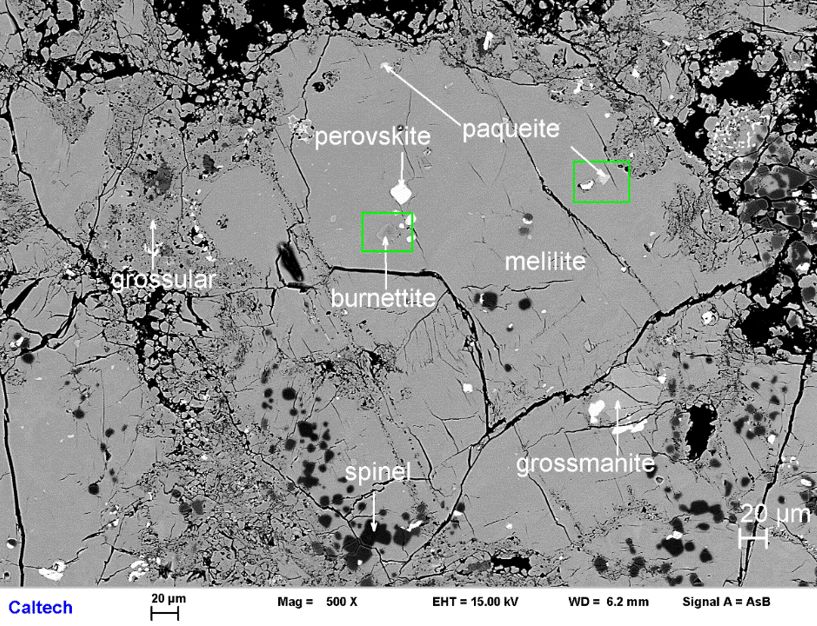
Division
of Geological and Planetary Sciences, California Institute of
Technology,
ABSTRACT
Paqueite (Ca3TiSi2(Al,Ti,Si)3O14;
IMA 2013-053) and burnettite (CaVAlSiO6;
IMA 2013-054), are new refractory
minerals, occurring as euhedral to subhedral crystals
within aluminous
melilite in fluffy Type A (FTA) Ca-Al-rich inclusions (CAIs), A-WP1 and CG-12,
from the Allende CV3 carbonaceous chondrite.
The type paqueite from A-WP1 has an empirical
formula of (Ca2.91Na0.11)Ti4+Si2(Al1.64Ti4+0.90Si0.24V3+0.12Sc0.07Mg0.03)O14,
with a trigonal structure in space group P321
and cell parameters a =7.943 Å, c = 4.930 Å, V= 269.37 Å3,
and Z = 1, which leads to a calculated density of 3.39 g/cm3. Paqueite’s
general formula is Ca3TiSi2(Al,Ti,Si)3O14
and the end-member formula is Ca3TiSi2(Al2Ti)O14.
Based on
Sc-Zr, there are two populations
of paqueite in FTAs with most paqueites from CG-12
in the low Sc-Zr group and all of the paqueites in A-WP1
in the high-Sc population. Vanadium
displays a similar pattern with all
paqueites from A-WP1 in a low-V
population and most paqueites from CG-12
in a high-V population.
Type
burnettite from CG-12
has
an empirical formula of Ca1.01(V3+0.56Al0.25Mg0.18)(Si1.19Al0.81)O6.
It assumes a diopside-type C2/c structure with a
= 9.80 Å, b = 8.85 Å, c = 5.36 Å, β = 105.6°, V= 447.7 Å3,
and Z = 4, leading to a calculated
density of 3.44 g/cm3.
Burnettite’s general
formula is Ca(V,Al,Mg)AlSiO6 and the end-member
formula is CaVAlSiO6.
Compositions of clinopyroxenes included in
FTA melilite generally form arrays of roughly constant V/Sc but they
can have highly
variable Ti. Spinel
and perovskite have
highly restricted V concentrations (0.14 – 0.73 wt.%) but V
concentrations in
hibonite are variable. A
common theme
among V-bearing phases in A-WP1 and CG-12 is that V concentrations are
restricted to one or two concentrations, suggesting that the phase
included in
FTA melilite were drawn from a highly restricted set of environments.
Burnettite
is a refractory mineral,
likely
condensates or crystallized from a melt,
and among the first solid materials formed in the solar nebula. Burnettite
is a V-rich clinopyroxene that can be Sc-, Ti-rich (coexisting melilite
is Sc-,
V-poor, < 0.03 wt% of the oxides), joining
other Sc-rich refractory minerals from carbonaceous chondrites. The
high Sc in
some burnettites is consistent with derivation from an ultrarefractory
parent
and the high Ti3+/Ti4+
(0.8–1.3), which is similar to
values for davisite and grossmanite from the same inclusion (0.6–0.9),
suggests
reducing conditions. Paqueite coexisting with clinopyroxene has lower Ti3+/Ti4+
(0.0–0.1 in bulk) but both phases imply reducing conditions. The
subequal
amounts of V, Sc, and Ti in some burnettites, davisites, and
grossmanites
suggests that there is a complete solid solution for these end-member
clinopyroxenes. Some
paqueite, a Ti-rich silicate, likely condensed in the
nebula but other grains may have formed through exsolution or been
involved in
partial melting.

SEM image of the two new minerals, paqueite and burnettite, in the Allende meteorite